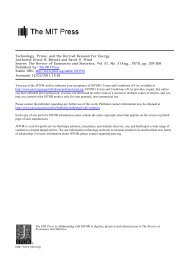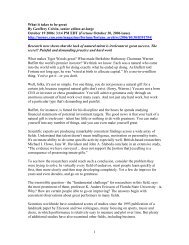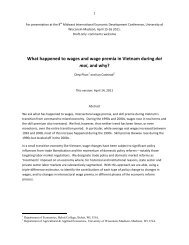Capital-Labor Substitution and Economic Efficiency Author(s): K. J. ...
Capital-Labor Substitution and Economic Efficiency Author(s): K. J. ...
Capital-Labor Substitution and Economic Efficiency Author(s): K. J. ...
Create successful ePaper yourself
Turn your PDF publications into a flip-book with our unique Google optimized e-Paper software.
CAPITAL-LABOR SUBSTITUTION AND ECONOMIC EFFICIENCY 239<br />
To carry out this analysis, it is necessary to<br />
have some indication of the values of the three<br />
parameters in sectors of the economy other than<br />
those examined in section I, <strong>and</strong> hence to have<br />
some direct observations on the use of capital.<br />
For this purpose, we shall determine the pa-<br />
rameters in the production function from data<br />
on comparable sectors in Japan <strong>and</strong> the United<br />
States. Although these two-point estimates may<br />
have substantial errors in individual sectors,<br />
the over-all results of this second method of<br />
estimation support the principal results of our<br />
earlier analysis <strong>and</strong> lead to some more general<br />
conclusions.<br />
A. Production Functions from<br />
US..-Japanese Comparisons<br />
The United States <strong>and</strong> Japan were selected<br />
for this analysis because of the availability of<br />
data on factor use, factor prices, <strong>and</strong> commodi-<br />
ty prices in a large number of sectors.'7 They<br />
also are convenient in having large differences<br />
in relative factor prices <strong>and</strong> factor proportions.<br />
The errors involved in estimating the elasticity<br />
of substitution are therefore less than they<br />
would be if there were less variation in the ob-<br />
served values. (For the data in section I, esti-<br />
mates based only on the United States <strong>and</strong><br />
Japan differed by less than i O per cent on the<br />
average from the regression estimates.)<br />
The elasticity of substitution can be esti-<br />
mated from these data by means of equation<br />
(24):<br />
Xi (K/L) j rj<br />
XU (K/L) u Wu<br />
ru<br />
where subscripts indicate the country. This<br />
method of estimation has the advantage of uti-<br />
lizing direct observations of capital as well as<br />
labor <strong>and</strong> of being independent of the varying<br />
value of the efficiency parameter y.<br />
The data for this calculation are taken from<br />
input-output studies in the two countries <strong>and</strong><br />
are summarized in Table 5. The main concep-<br />
"7The compilation of these data on a comparable basis<br />
has been done by Gary Bickel, who is conducting an exten-<br />
sive analysis of the relation between factor proportions <strong>and</strong><br />
relative prices in the two countries. Further discussion of<br />
the data is given by Bickel [41.<br />
J<br />
tual difference from section III is in the defini-<br />
tion of capital, which here includes only fixed<br />
capital. The labor cost in Japan makes allow-<br />
ance for the varying proportions of unpaid<br />
family workers in each sector. The variation in<br />
relative factor costs shown in column (4) is<br />
due entirely to differences in labor costs, since<br />
the relative cost of capital is assumed to be the<br />
same for all sectors.<br />
The values of C- derived by this method vary<br />
considerably more than those derived from<br />
wage <strong>and</strong> labor inputs alone in section I. How-<br />
ever, for the I2 manufacturing sectors in which<br />
both are available, there is a significant correla-<br />
tion of .55 between the two estimates.'8 The<br />
weighted median of a- for these sectors is .93 as<br />
compared with .87 by the earlier analysis. The<br />
median c- is also .93 for all manufacturing. The<br />
omission of working capital provides a plau-<br />
sible explanation of this difference, since the<br />
little evidence available indicates that stocks<br />
of materials <strong>and</strong> goods in process are generally<br />
as high in low-wage as in high-wage countries.<br />
The elasticity of substitution between working<br />
capital <strong>and</strong> labor is therefore probably much<br />
less than unity. This correction is particularly<br />
important in trade <strong>and</strong> in manufacturing sectors<br />
having small amounts of fixed capital.<br />
Since these two-country estimates are rea-<br />
sonably consistent with our earlier findings for<br />
the manufacturing sectors, we will tentatively<br />
accept them as indicative of elasticities of sub-<br />
stitution in non-manufacturing sectors, with<br />
qualifications for the omission of working capi-<br />
tal. Here the most notable results are the rela-<br />
tively high elasticities in agriculture <strong>and</strong> min-<br />
ing, <strong>and</strong> the low elasticity in electric power.'9<br />
In trade, the omission of working capital prob-<br />
ably leads to a serious overestimate of the elas-<br />
ticity of substitution, while for other services<br />
we have no comparable data. The evidence of<br />
relative prices, however, suggests an elasticity<br />
for personal services, at least, of substantially<br />
less than unity.<br />
18 In some sectors the correspondence between the in-<br />
dustries covered is very imperfect because the earlier esti-<br />
mates are on a 3-digit basis <strong>and</strong> cover only part of the 2-<br />
digit class.<br />
19 The transport sector involves a very large difference<br />
in product mix, <strong>and</strong> the reliability of the estimate is doubtful.







